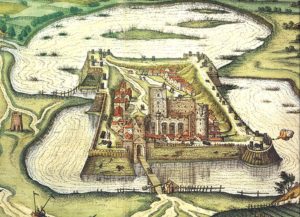1585: the duel of Olasz Gergely at Komárom Castle

It was 435 years ago that Archduke Habsburg Ernő (Ernst), the Chief Chairman of the Court Military Council of Vienna wrote a letter to the Pasha of Buda in which he demanded him to ban the Ottoman warriors serving under him in the Ottoman Borderland castles to stop challenging the Hungarians for duels. The duels were banned at large and it was punished when someone answered a challenge but not answering it was equal with eternal shame…The folks on both sides of the Borderland were considered as the members of the so-called Valiant Order. They had to face a great dilemma of living in shame or disobeying orders.
You can read more about the Valiant Order here:
https://www.hungarianottomanwars.com/essays/members-of-the-valiant-order/
The Archduke even indicated the names of those Hungarian Borderland “places” or “houses” (forts) where the complaint had come from (Vár)Palota, Tata, and Győr. Let me remark that the Hungarian surname “Olasz” means “Italian” in the English language so our hero may have been related to the Italians. Please, also note that I am intentionally using the Eastern name order for Hungarian names whereas the family name comes first.

“It has occurred during the year that a Voivode of the Boaters of Komárom, Olasz Gergely had a duel on foot. He fought against his Turk opponent on the field of Komárom. It was Olasz Gergely himself who reported that he had his opponent brought down to the ground and killed him. This fight took place in front of the Turk and the Hungarian army, with the permit of Captain Pálffy Miklós.”
We know that the fighters had to agree on whether they would fight on foot or horseback. On foot, it is recorded that they used sabers and sometimes an “iron rod” in their left hand. It would be interesting to see how they used these two weapons at the same time.
We also know that it was Vice Captain of Komárom, Thúry Márton, the officer of Olasz Gergely who had been exchanging letters with Agha Sahin and Agha Iskander. The time of the duel was set (and permitted in writing) by Captain Pálffy to allow the Turks to escort their champion to the location in great military pomp, according to the habit of the Valiant Order of the Borderland.
Here is more about the 1,000-mile-long Hungarian-Croatian Borderland that separated Christendom and the Ottoman Empire between the 1420s and 1699: https://www.hungarianottomanwars.com/essays/the-borderland/

In general, these duels have been taking place all the time between the Turks and the Hungarians (and Croatians) since the Ottomans appeared in the Carpathian Basin in the 15th century. They were the parts of the “small war”. No wonder the duels had their own unwritten rules which were observed by both sides. Most of the time they ended with a great merry-making whereas Turks and Hungarians drank and ate together, sometimes wrestling and horse racing were included.
Source: Szerecz Miklós

Dear Readers, I can only make this content available through small donations or by selling my books or T-shirts.
If you like my writings, please feel free to support me with a coffee here:
You can check out my books on Amazon or Draft2Digital, they are available in hardcover, paperback, or ebook:
https://www.amazon.com/dp/198020490X
or at https://books2read.com/b/boYd81


My work can also be followed and supported on Patreon: Become a Patron!http://Become a Patron!


https://hungarianottomanwars.myspreadshop.com/

https://hungarianottomanwars.myspreadshop.com/all


